Dawn has inspired some of the most memorable music. Delius, Grieg, Mascagni, Rossini, Strauss and Wagner come most readily to mind. This week, it provided the unifying theme for Andris Nelsons’ program in the first of his final four Symphony Hall appearances this season. Ravel’s Alborada del gracioso led off, followed by the American premiere of Thierry Escaich’s second concerto for cello and orchestra, Les Chants de l’aube. Even if the curtain closer, Rachmaninov’s Second Symphony, depicts no literal dawn, it does end in a sunburst of light and pealing bells, dispelling the darkness shading much which preceded.
Though it references a genre of song, Ravel’s eight-minute piece is dance-driven save for the buffoon’s lament, first voiced by a forlorn bassoon. Rhythmically sharp and brightly colored, Nelsons’s Alborado did not caper as lightly as it could have, kept earthbound by a peculiar heaviness.
Escaich’s concerto, on the other hand, benefited from Nelsons and Gautier Capuçon having already collaborated on the world premiere with the Gewandhausorchester Leipzig last month. In pre-performance remarks the composer compared his concerto to stained glass. Shards of colors, rhythms, different registers, melody and genres are introduced by the cello or drawn out of the orchestra, juxtaposed, overlapped and sometimes blended. The resulting layering of textures and timbres is eclectic.
The second movement, Le Rivage des chants, stacks African inflections, Gregorian Chant and jazz. The cello dominates throughout, prompting or seconding the orchestra and engaging individual instruments like the harp, timpani and first cello in dialogue. Escaich employs the full range of the instrument and uses challenging cadenzas to transition from movement to movement. The final movement gives way to more transparent textures approximating dawn. A calm and serene cello solo is interrupted by the gradual intrusion from the orchestra of what Escaich terms a “ritual and obstinate dance” adumbrating shards from previous movements as it grows in power and intensity, triggering a blindingly rhythmical sunburst to close. Capuçon’s complete immersion and commitment, equalled by Nelsons’, resulted in a dramatic and eloquent performance. Escaich couldn’t have asked for better advocates.
Nelsons performed Rachmaninov’s Second Symphony uncut. Though it clocked in at 63 minutes, the performance seemed anything but long. Nelsons created a fluvial ebb and flow both rhythmic and melodic appropriate to each movement within which the various episodes were molded and rose and fell organically. Though Mahler and Rachmaninov are rarely mentioned in the same breath, the way Nelsons highlighted the various opening fragments as they sounded then coalesced into the symphony’s seminal motto definitely brought the Austrian composer to mind. Recurrences of both the motto and various permutations of the Dies irae were given the proper space and emphasis to establish continuity in the flow. Plush and alluring sonorities, particularly from the strings, prevailed. After the preceding turbulence and turmoil, the radiant closing coda announced the third dawn of the program. It is unfortunate, then, that a persistent, high pitched whistling sound like a leak from an oxygen tank marred such a nuanced, sensitive performance. Whether it was audible beyond the few rows around us or not, it was still a nagging distraction.




